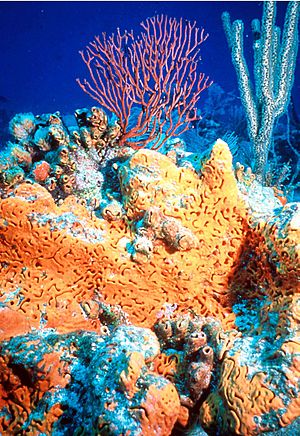Filozoans facts for kids
Quick facts for kids Filozoans |
|
|---|---|
 |
|
| Orange elephant ear sponge, Agelas clathrodes, in foreground. Two corals in the background: a sea fan, Iciligorgia schrammi, and a sea rod, Plexaurella nutans. | |
| Scientific classification |
|
| (unranked): | Unikonta |
| (unranked): | Obazoa |
| (unranked): | Opisthokonta |
| (unranked): | Holozoa |
| (unranked): | Filozoa Shalchian-Tabrizi et al., 2008 |
| Subgroups | |
|
|
Filozoa is a special group of living things. Scientists call such a group a clade. It includes all animals and their closest single-celled relatives. These relatives are tiny organisms made of just one cell. They are more closely related to animals than they are to fungi or other similar groups.
There are three main groups within Filozoa. These are Filasterea, Choanoflagellatea, and the Kingdom Animalia. Animalia is the group that contains all the animals you know, from tiny insects to huge whales.
How Filozoans Evolved
Scientists use something called a phylogenetic tree to show how different living things are related. It's like a family tree for life! This tree helps us understand how different groups, like Filozoa, have changed over millions of years. It shows how older groups split into newer ones.
The tree below shows how Filozoa fits into the bigger picture of life. It starts with a very old group called Opisthokonta. This group lived about 1.3 billion years ago.
| Opisthokonta |
|
||||||||||||||||||||||||||||||||||||||||||||||||||||||||||||||||||||||||||||||||||||
See also
 In Spanish: Filozoa para niños
In Spanish: Filozoa para niños



